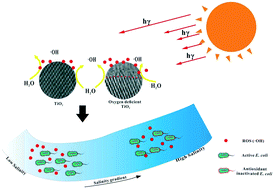Cytotoxicity of TiO2 nanoparticles toward Escherichia coli in an aquatic environment: effects of nanoparticle structural oxygen deficiency and aqueous salinity†
Abstract
Although the cytotoxicity of TiO2 NPs has been examined on various biological species, it remains a mystery how the NPs' crystal structural deficiency (i.e., oxygen vacancies and other structural defects) may affect their reactivity toward living organisms. Here we present a model study using precursor TiO2 NPs (i.e., anatase, rutile and P25) and their structurally defective derivatives that contain relatively large amounts of oxygen vacancies (namely TiO2-OD NPs) to investigate the NPs' cytotoxicity toward E. coli cells, considering salinity as an important estuarine environmental factor. The results showed that the presence of oxygen vacancies in the TiO2 NPs had a direct effect on the NPs' photocatalytic reactivity and generation of surface reactive oxygen species (ROS), leading to significantly increased cytotoxicity of the TiO2-OD NPs in comparison to their precursor NPs under UVA irradiation, especially for anatase and P25. Further, it was revealed that the aqueous salinity played an important role in affecting the interactions of the E. coli cells with the TiO2/TiO2-OD NPs. At elevated salinities, the concentrations of surface ROS were consistently lowered for the tested NPs, but the antioxidant gene expressions in the tested cells were also dramatically suppressed, and thus, the overall demonstrated cytotoxicity of the TiO2 and TiO2-OD NPs were increased at higher salinities. This finding was verified by the results of cytotoxicity tests for the TiO2 and TiO2-OD NPs using natural estuarine water. As such, our work has provided new insight into the impact of engineered nanoparticles on the microbial ecology in brackish waters.



 Please wait while we load your content...
Please wait while we load your content...